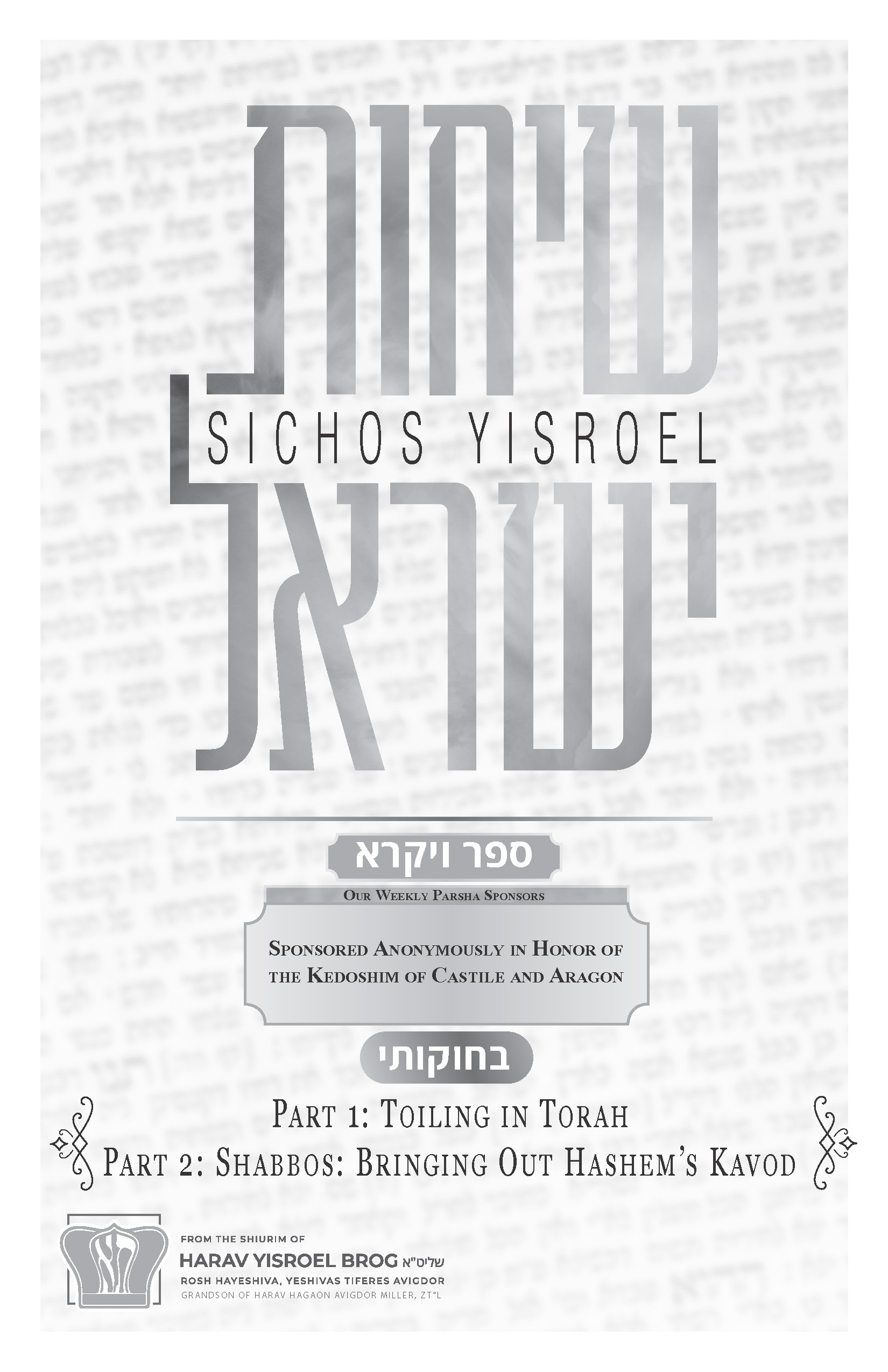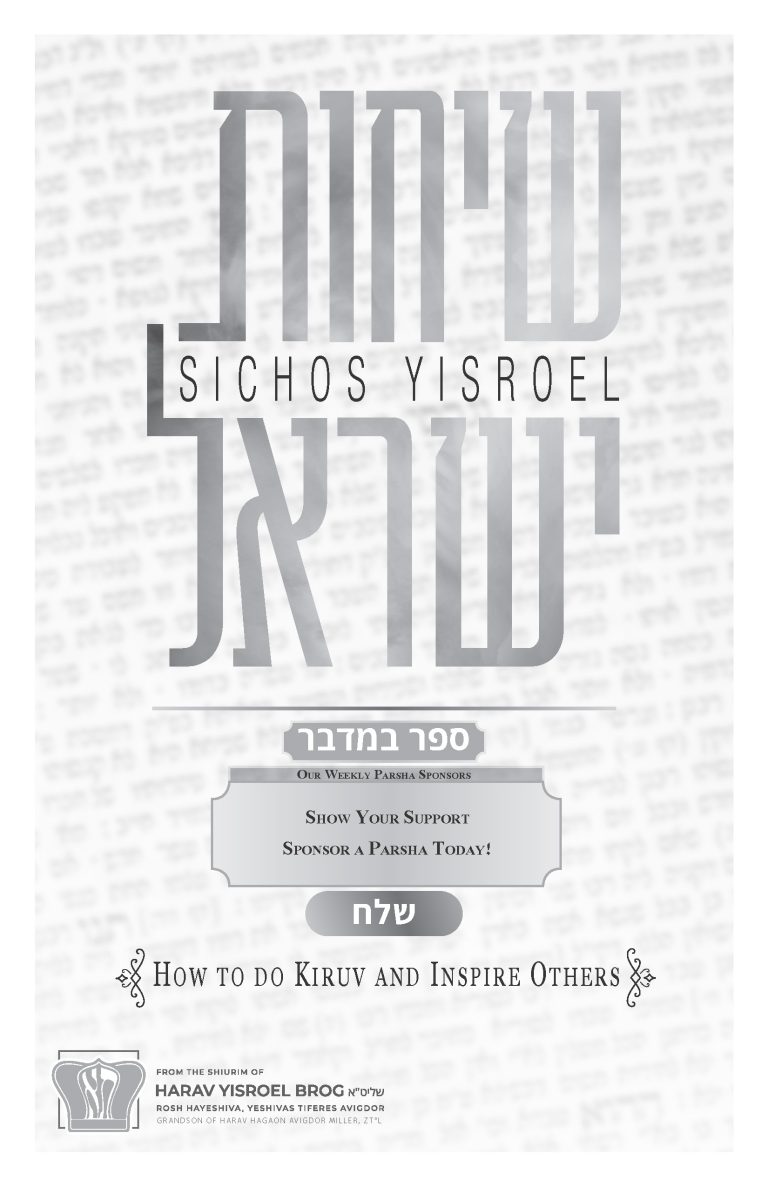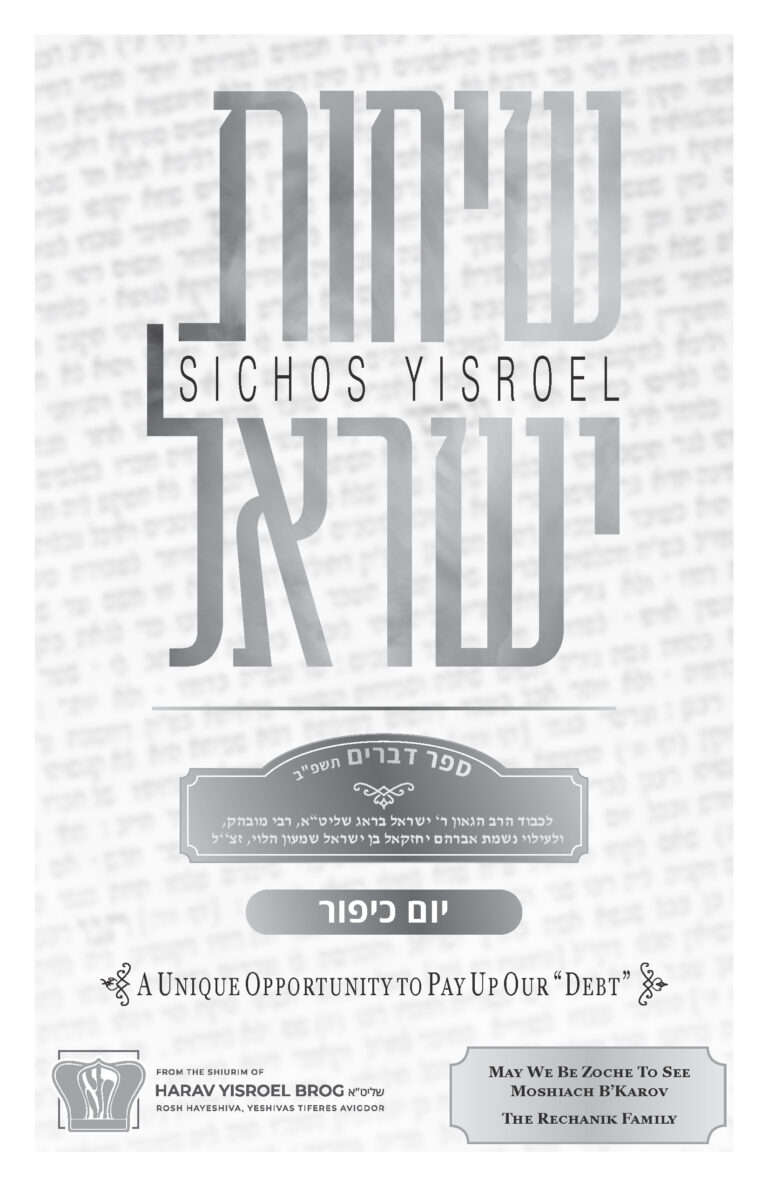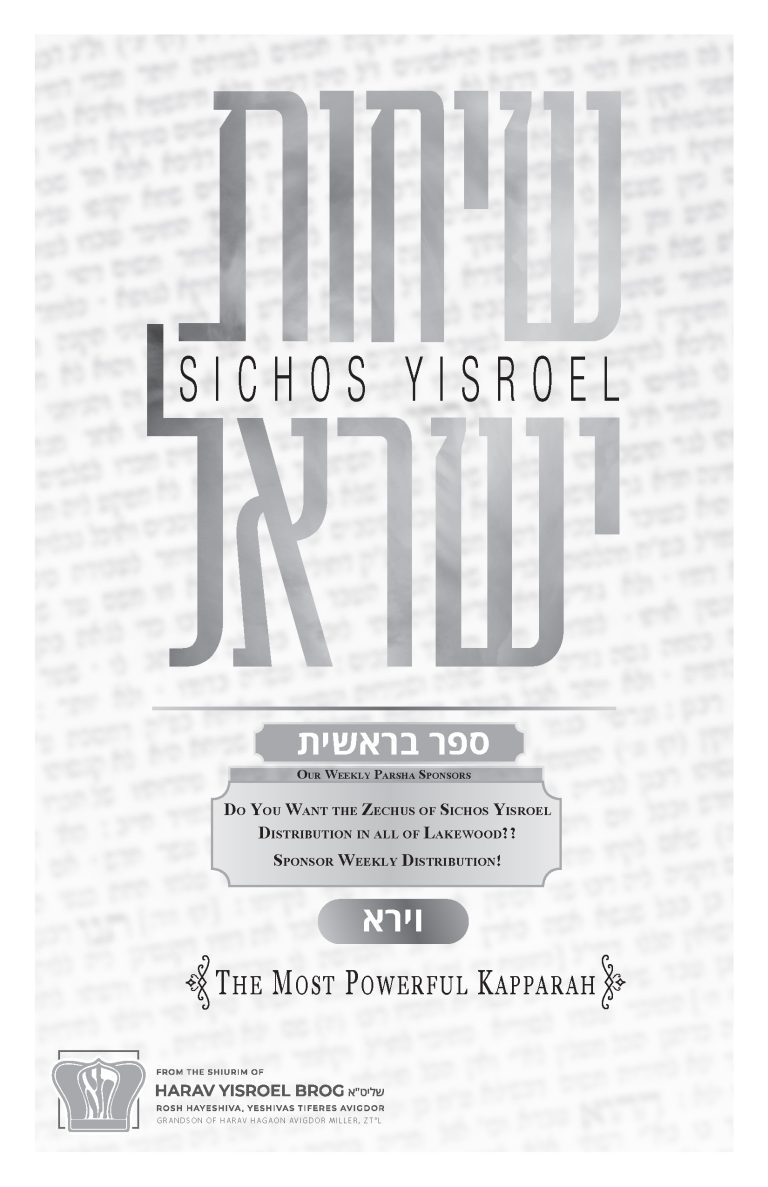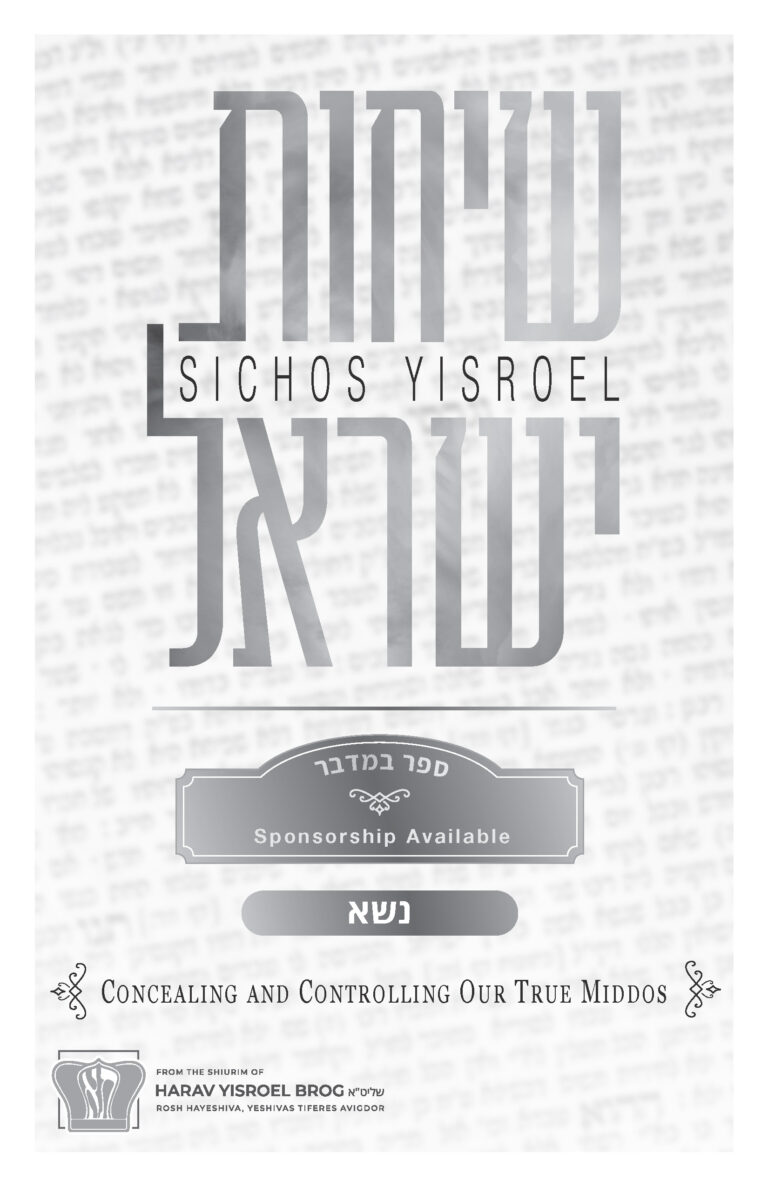Bechukosai 5784: Toiling in Torah
Sponsored
Anonymously in Honor of
the Kedoshim of Castile and Aragon
Consider sponsoring a shiur
Visit YTATorah.org
Shiur presented in 5782 & 5772
Part 1: Toiling in Torah (5782)
Part 2: Shabbos: Bringing Out Hashem’s Kavod (5772)
Part 1: Toiling in Torah (5782)
Why is Ameilus BaTorah Mentioned Separately?
Similarly, when the pasuk (v. 14) says ואם לא תשמעו לי, “and if you will not listen to Me,” Rashi says when it says ולא תעשו, “and you won’t do the mitzvos,” it means “all mitzvos” you won’t do. So what does it mean ואם לא תשמעו לי? It means, if you won’t listen to Me, to be amal baTorah.
What’s the obvious question over here? The first time I heard this question from my rebbi (Rav Meir Halevi Soloveichik) I gave myself a mock patch. Why didn’t I think of that pashute kasha!? The question is, when it says in the first part of the pasuk that you should observe all My mitzvos, that means all of 613 mitzvos. One of those mitzvos is talmud Torah. So talmud Torah is already covered! So what’s the gemara saying that ובחוקותי תלכו refers to the mitzvah of Torah? That’s already included in ואת מצותי תשמרו. Talmud Torah is also a mitzvah like all other mitzvos! It says ושיננתם לבניך ,ודברת בם ולמדתם אותם. So why would the Torah require a separate tzivuy (command) to be amal in Torah? What does that teach me?
So the rebbi said a moradige zach. He said, what’s muchach from here is that for all the other mitzvos there’s no obligation of ameilus. If there would be an obligation of ameilus for all mitzvos, then ameilus baTorah should also be included. So perforce then, when we say, ואת מצותי תשמרו, it means you have to observe My mitzvos but there’s no obligation of ameilus! But when it comes to Torah it’s more than just fulfilling the mitzvah of talmud Torah. Over here, there’s a specific obligation to be amal baTorah!
Now we have to know what’s the difference. How come? Vus shtait dah? This is a Brisker mind at work.
Getting Sechar for Tirchah for Mitzvos
We all understand that we have to do mitzvos even if the mitzvos are hard. You have to do mitzvos no matter what. So what’s the chiluk? The rebbi said there’s a tremendous yesod here. And that is, that concerning all mitzvos, any difficulty, any toil that’s involved in fulfilling the mitzvah is an obligation – but it’s not a chelek of the fulfillment of the mitzvah. Let’s say it’s hard for you to go do a mitzvah, you’ve got to do it anyway. There’s no exemption just because it’s hard. And if you exert yourself to do the mitzvah, you will get sechar for that mitzvah. For that tirchah that you put in, you will get rewarded. But it has nothing to do with the fulfillment of the mitzvah. There is no difference in the fulfillment of mitzvas tefillin between a person who works hard to fulfill it and a person who does not work hard to fulfill it. The tefillin is the same tefillin. Somebody who keeps Shabbos and it’s very difficult for them or somebody who keeps Shabbos and it’s not difficult for them – both are fulfilling the mitzvah of keeping Shabbos. Extra tirchah means you’ll get rewarded for the extra tza’ar, but there’s no chiluk in the person’s mitzvah of Shabbos if he fulfills it with difficulty or with ease.
But in Torah, there’s a fundamental difference between fulfilling the mitzvah with or without toil, ameilus. You hear that yesod? It’s a very important yesod for you to hear! Torah learned without ameilus and Torah learned with ameilus is two different limud Torahs. One guy learns one page of gemara with ameilus, and another guy learns a page of gemara without ameilus. These are two different mitzvos! But if one guy has a strained shoulder and he puts on tefillin and he’s muching and he’s krechtzing as he’s putting on his tefillin, while another guy is in good shape and puts those tefillin on, wraps around, no sweat – it’s the same mitzvah of tefillin.
Ameilus is for Everybody!
By limud haTorah you have to know that the toil in the learning is not just a heicha timtza, the means of how to learn. That is the actual mitzvah and that’s one of the conditions required in fulfillment of the limud Torah. Learning Torah must come through toil. And even if somebody has a very sharp mind – i.e., the guy is highly intelligent and as soon as he opens a gemara he chaps it quickly – he also has to toil in Torah. And if he doesn’t toil in Torah, he’s not fulfilling the mitzvah of talmud Torah properly. Toiling in Torah is not just for somebody who is lacking the ability to learn. Every single person has to toil in Torah.
It’s pretty strange to think about it. We think if you’re very smart, you can get away without toiling. If you’re not so smart, you’ve got to work hard. But that’s not the mitzvah. Now, for people who are not so smart, you know what? They for sure have to work hard. But, it’s the people who are smart who have the harder challenge because they figure, “Why should I work hard in learning Torah? I don’t have to work hard.”
You have to know that lacking ameilus, lacking toil is a chisaron, is a lack in the essential fulfillment of the mitzvah of talmud Torah. This is an amazing thing. So let’s say a person is listening to a shiur, listening to a class, and it’s very easy. It’s not hard. That’s not called toiling. He’s not fulfilling the mitzvah of talmud Torah properly.
It’s an amazing zach. A person could listen to a shiur and it comes easy to him and he doesn’t have to toil to chap the shiur – that person has not fulfilled the mitzvah of talmud Torah properly when listening to that shiur.
My rebbi said another moradige zach. Let’s say a person works very hard to fulfill a mitzvah. He puts a lot of tirchah in to do a mitzvah. For example, let’s say he doesn’t have tefillin. He has to matriach himself to get tefillin. And he doesn’t end up getting the tefillin. Did the guy accomplish anything? Zilch. Do you know why? Because he never put the tefillin on. If you didn’t put the tefillin on, it’s nothing. You didn’t accomplish anything!
But let’s say a guy is working hard to understand the gemara and he tries and he tries and he tries and he doesn’t chap it. Have you heard of such things? Nu? You know what my rebbi said? The person was mekayem the mitzvah of toiling in Torah, even if after all the toil he didn’t chap the pshat in the sugya and he can’t be meyashev the sugya and he can’t come out with clear conclusions. The etzem ameilus, the toil in itself, that is the essence of the mitzvah.
Pushing Yourself to the Max
What is the definition of toil? This is another major mistake that many people make. What does it mean ‘toiling in Torah’? Toiling in Torah means you’re toiling in the actual learning of the Torah. But let’s say a guy is toiling for things that bring to Torah. For example, let’s say the guy travels a far distance to go learn Torah. Is that ameilus baTorah? No. Let’s say a guy doesn’t know how to transplate. And the guy has to break his teeth on the teitch. This happens to most people at one point or another. Maybe in the beginning of your career it’s more common. The guy says, “I was toiling in Torah.” No. That’s not called toiling in Torah.
My rebbi used to say over from his father (the Brisker Rav) that people who think that’s called toiling in Torah are mistaken. Let’s say a guy needs a sefer to explain the gemara to him and he has to go shlep a ladder and he has to put the ladder up against the bookshelf and climb up high, when he’s afraid of heights to get that sefer. Is that ameilus baTorah? No.
Ameilus baTorah begins once the person knows what it says in the gemara. Vus shtait. And he now is beginning to try to understand. Sometimes you see a gemara and there’s a machlokes. Somebody says, “What are they arguing about? I really don’t know. I’m all mevulbal.” That’s not called ameilus baTorah. Figuring out vus shtait dah, what it says, is not a kiyum mitzvah of ameilus baTorah. It’s a side thing. Will the guy get some sechar for that? Sure. Why not? It’s not less important than any other mitzvah. It’s a preparation for a mitzvah. But to be mekayem the law that says אם בחוקותי תלכו, that only starts al yedei amal in limud haTorah. That’s a very great principle that my rebbi was moser to us from his father. Rashi says in Berachos (6b) the sechar of Torah is toiling to understand, when you’re meyageiah in the sevaros, you want to understand more than simple facts.[i]
When a person is working besha’as the shiur to chap the shiur, to understand it, or when a person afterwards reviews the shiur to get a deeper understanding, and to see where he could challenge himself to discover more and where he could understand more – that’s ameilus.
Rav Zalman Volozhin’s Midnight Run to Vilna
There’s a story brought down in the sefer called Toldos Adam. Toldos Adam is a sefer that a big talmid chacham wrote about Hagaon Rav Shlomo Zalman of Volozhin (1756-1788), the brother of Rav Chaim (1749-1821). He was known as Rav Zelmele. This man was a superstar. Ad kedei kach he was such a superstar (he was also a talmid by the Vilna Gaon) that somebody asked Rav Chaim Volozhiner once, “Your brother knows kol haTorah kulah by heart. Literally. What’s the difference between him and the Gaon? He seems to be as big as the Vilna Gaon.” You hear? A good question. A man who knew kol haTorah kulah ba’al peh. You know what Rav Chaim said? “Ah! He doesn’t come near to the Gaon.” They asked, “What’s the chiluk?” He said, “I’ll tell you. If you ask my brother Torah, he knows kol haTorah like most people know asher yatzar.” Most people hopefully know asher yatzar by heart. They did it a couple of times so they can say it by heart. But go up to a guy and tell him, ‘Say asher yatzar backwards. Can you say asher yatzar backwards? Try it.’ No, you can’t.
How could you read asher yatzar backwards? If you opened up a siddur and you looked inside, you’d break your teeth but you could read it backwards. You’d say la’asos umafli basar kol.
He said, “My brother knows kol haTorah kulah ba’al peh, but by the Vilna Gaon, the whole Torah is an open book in front of him. He could read it backwards and forwards equally because it’s כתבם על לוח ליבך. He can read it backwards and forwards.” He fulfilled the madreigah of pashut writing the Torah on his heart.
So, there was a story which Rav Leib ben Rav Ber from Vilna related about Rav Zalmele. He said, one time he was learning in a beis hakenesses late at night in a little village outside of Vilna called Shnipishek. In the middle of the night, Rav Zalmele was overcome with a great desire. He needed a certain chashuve sefer that wasn’t in this little village, but it was in the library in Vilna. So he didn’t waste one second, and he ran in the middle of the night by himself. He had to cross over a river. He ran into Vilna and he came to the library. He said his knees were knocking one against the other because of the terrible cold that was outside. It was freezing. But he went there to learn. After he finished learning from that sefer, some chashuve people in the shul who saw that he arrived in the middle of the night to look at the sefer, asked him, “Tell us, why were you matriach yourself to come all the way from Shnipishek to Vilna in the middle of the night. It’s so freezing. What’s the pshat? What was the cheshbon?”
Listen to what he said. He said, “It’s an ofene passuk in the Torah. The Torah says (Devarim 30:12)[ii], לא בשמים היא לאמר, Torah is not in shamayim that somebody would have to say, ‘Who is going to go up to shamayim to take it for us?’ And it’s not across the sea that somebody could ask, ‘Who is going to cross the ocean to take it for us?’ So Chazal (Eruvin 55a) say a peledike zach.[iii] You know what the message of this passuk is? You see an amazing thing from this pasuk. שאם בשמים היא, if it would be in shamayim you would have to figure out a way to get up there! And if it would be across the sea, you’d have to cross the ocean to get there.” So he said, “A small distance from that little village to the library in Vilna? Nu. It’s not as far as shamayim to aretz. It’s karov hu. It’s even closer than me’eiver leyam. So I shouldn’t have to go and do that?” So he held halachah lema’aseh he had to do it.
There is another ma’aseh brought down in the sefer Toldos Ha’adam about Rav Zalmele. One time he was overcome with a great desire to learn a certain sefer. The problem was there was a huge box blocking that sefer, and the box would have taken three people to move it. So Rav Zalmele walked back and forth in the room and he began to learn and repeat to himself the following Chazal. He started to say, “Afilu bashamayim you’re chayav to go after it.” And he started saying it with such a gevaldige bren, with such hislavus, with such fire! And anybody who heard him was mamash impressed and was overwhelmed by the sweetness and the love that he had for Torah. He kept repeating it until he felt within himself tremendous strength. He ran over to this box that was in his way that three people had to carry. He grabbed this box and he moved it – and he got the sefer! People who watched him do this thought it was like a ‘Hercules.’
Now my rebbi said, “You know what you see from this? That all the amal, all the tirchah, all the exertion and all the effort that a person makes, has no shaychus to ameilus baTorah. Otherwise, you know what our passuk should have said? It should have said: אם בחוקותי תלכו…שתהיו עמלים בתורה. It would have said that in the pasuk. In the Torah it says that all the exertion and effort is not called ameilus baTorah. It’s tremendous. That’s the other passuk (in Devarim 30:12), לא בשמים היא – that teaches me that ‘I’m going to exert myself to cross the yam and go to shamayim,’ but that superhuman exertion and effort (like walking for few miles to a shul to learn from a particular sefer or moving a heavy bookshelf to reach a sefer), is still not an essential part of the learning of the Torah!”[iv]
If a guy has a very difficult time, he has arthritis and he has a hard time opening up the gemara and he works very hard, he’ll for sure get sechar for that! But that’s not called ameilus baTorah.
Exertion is Not the Same as Toil
My rebbi said, “My father used to say constantly that nowadays we have no concept of toiling in Torah. We have no concept of what it means to hureve in learning. What most of us do know is how to bring ladders to the bookcase and to climb up the ladders to get a sefer. That’s the extent of what our toil is.” This is an amazing thing to know. This is a mitzvah in the Torah. It’s a chiyuv to be amal baTorah. A person could go through his whole life without ever toiling in Torah.
A talmid once came to Rav Baruch Ber and he told him over a shtickel Torah in the Rashba. So Rav Baruch Ber said, “Did you ever, once in your life, toil over a Rashba to the point that you got sick? You just ‘play’ with the Rashba. You are toying with the Rashba. That’s not called learning Torah. That’s not called learning a Rashba.” You know what that means?! It’s unbelievable!
Staying in Kindergarten
Sadly, most of our learning is that. We just don’t know the teitch, so we get a Jastrow. Then, they had a Soncino. Some guy in Lakewood who finished Shas many times told me, “My rebbi is Rebbi Artscroll.” He said, “This is my rebbi!” He chazered Shas many times. This nice person has a whole program to get everybody else to chazer Shas with him. But I told him, “You were never amal baTorah. Where is your ameilus baTorah? Tell me one gemara you were on amal on.” I said, “What are all your chazaros worth?” The guy has been chazering shas numerous times. I asked him what are you using now? He said, “My rebbi. I don’t move from my rebbi.” I told him, “After so many chazaros, you’re like the guy in kindergarten who went there for the last ten years. He doesn’t move on to first grade. Okay, so you needed it for ten years for your first fifty chazaros. You chazered shas so many times. You still can’t learn shas today without an Artscroll?” But he’s still holding by step one to figure out what the words mean.
A mentsch has to know that toiling in Torah is where it’s at and all of the brachos, all of the hatzlachos that the gemara says one gains through learning Torah is only through toiling in Torah. Only through toiling!
Toil Means to Straighten Out Your Seichel!
There was a man named Rav Naftali Zilberberg (1850-1930). He was a tremendous rav and talmid chacham from the city of Warsaw, and was known as “The Warsaw Tzaddik.” He writes, “I’m going to share with you something that I heard from my rebbi, the gaon, the Sha’arei Simchah, in the name of Rav Akiva Eiger. Rav Akiva Eiger warned his talmidim, the gaonim and the many talmidim of his talmidim, that the main toiling in learning should be layhasher haseichel, to straighten out your seichel, to know how to think straight. He says, even if al yedei zeh you will miss bekius because you can’t do both – either be’iyun where you straighten out your mind, or you put efforts into bekius. He explains that somebody whose seichel is yashar be’emes truly straight, his seichel hayashar will protect him and prevent him from going off on tangents and coming up with ideas that are counter to the gemara and counter to the Tosfos and counter to the Ramban.
A Krumkeit Impedes True Understanding
If a man doesn’t have seichel hayasher, there’s a very simple test. Tell him to go learn Ramban. You know what the first thing he says is? “Nah, it doesn’t make sense.” Tell him to go learn a Tosfos. You know what he says? “Tosfos, it’s not yashar. It’s not pashut pshat.”
You know what Rav Akiva Eiger said? The guy has krumme kup. If you learn and acquire seichel hayashar, you’ll be prevented from challenging the Torah’s seichel. כי כל דברי קדשם, all of their holy words – the Ramban, Tosfos – מיושרים בתכלית, are yashar, are right and straight betachlis hayashrus. וההיפוך מדבריהם, and the opposite of their words, היא עקום בתכלית, is crooked betachlis. Shpitz krumkeit. He says, a ba’al seichel hayashar will not allow himself to sink into the mud of krumme Torah and end up in that bitter Gehinom, rachmana litzlan meihei dayta. Hashem should save us from this da’as. That’s from Rav Naftali Zilberberg.
Develop Your Mind to Think Torahdik
Whenever you learn, you have to always ask yourself, “Am I being an amal in this Torah?” Diligence is wonderful. Halevai. But you have to first fulfill the requirement of discernment in learning. Thinking in learning. Acquiring a Torah mind. To think Torahdik.
My rebbi used to say to me many times that people would come and suggest a chiddush to his father, the Brisker Rav. His father would say, “Oy yoy, oy yoy. I can’t hear that. I can’t hear that.” The guy would say, “What do you mean?” The Brisker Rav would say, “That’s not Torah. That thought is not Torah.” There were kashas, there were Torahdike kashas, but certain kashas weren’t Torahdike kashas and those kashas you weren’t allowed to ask. And if you say krumme Torah that has nothing to do with Torahdike seichel, that’s not Torah either. You may be using Torah words or borrowing Torah words but you’re not being amal baTorah.
A person needs to develop his mind to think Torahdik. If you think Torahdik, then you are truly being amal baTorah. That’s why the Torah explains and clarifies the special mitzvah in this week’s parshah of being amal baTorah.
Part 2: Shabbos: Bringing Out Hashem’s Kavod (5772)
Shabbos’s Mate
There is a famous medrash (Bereishis Rabbah 11:8).[v] It says: תני ר׳ שמעון בן יוחאי, R’ Shimon bar Yochai, the Tana, taught, אמרה שבת לפני הקב״ה, Shabbos said to Hakadosh Baruch Hu, רבונו של עולם לכולן יש בן זוג, for everyone there is a mate, ולי אין בן זוג, but for me, Yom Hashabbos, there’s no ben zug – I don’t have a mate. Hakadosh Baruch Hu answers, כנסת ישראל היא בן זוגך, Klal Yisrael is your mate. And when Klal Yisrael came before Har Sinai, אמר להם הקב”ה, Hakadosh Baruch Hu said to them, זכרו הדבר שאמרתי לשבת, Hakadosh Baruch Hu told Klal Yisrael, remember what I said to Shabbos, כנסת ישראל היא בן זוגך.
So there are several questions here. What does it mean, everyone has a ben zug? Who is everyone? What are we referring to? Second of all, what does that mean, a mate? Thirdly, why didn’t Shabbos have a mate when everyone else had? Did Shabbos have a mate and lost it, or was it not given one from the start?
So there are a number of pshatim. Today, we are going to share with you the biur on this Chazal from the Vilna Gaon (Biurei HaGr”a on Bava Kama 32b; quoted partially).[vi] More widely known in the velt are pshatim from the world of Chassidus,[vii] but today we’re going to learn from another source.
לכולן נתת בן זוג, what are we referring to? It’s referring to days. Every day has a mate. What does it mean, every day has a mate? I thought there were six days, sheishes yamim. There is yom rishon, there is yom sheini, yom shlishi. Where are the mates? Zogt der Vilna Gaon that yom rishon and yom revii are mates. Why? Because on both of those days, Hashem created ohr. So therefore, yom alef was related to yom daled. Similarly, yom sheini is related to yom chamishi because on both of those days, Hashem created mayim, and something with mayim. And yom shlishi is a mate of yom shishi because on both of those days, Hashem created something related to the aretz.
Now, this is just a haschalah, we are just walking in the door. But at least now we know what we’re talking about. Chazal are telling us that the days have mates. A chiddush. Each day is not an independent day. Yom alef is a mate with yom daled because they have something in common, which is ohr. Yom beis with yom heh – mayim. Gimel with vav – aretz. Now we have to understand: why is that considered a mate? Maybe that’s similar. But calling it a mate?
The Tachlis of the Briah
Says the Gaon that the pshat as follows. What is the tachlis of the briah? The tachlis in the briah is to reveal kavod shamayim. Everything I created, Hashem says, I created for My kavod. To bring out My glory. You should become aware and be able to see and chap that there is a Borei olam in the world.
Now, how do things bring out kavod shamayim? So, for example, on yom alef, Hashem created ohr and choshech, light and darkness. On yom daled, Hashem created meoros,which means that he created the sun and the moon. So the creation of ohr and choshech came to its shleimus; it reached its pinnacle from this zivug of yom alef together with yom daled. Now it was completed. And now that it was completed, the kavod of shamayim was fully revealed. When you see a half-baked object, it’s choser, it’s lacking in the kavod shamayim. But now with yom daled, there is a davar sheleim.
The same is with the days when Hashem created mayim. The two days of mayim brought out the shleimus of mayim. The two days of aretz brought out shleimus and kavod shamayim.
However, Shabbos was without a mate. Now, the shaaleh is, why? So the teretz is that Shabbos also had a mate. Initially, it had a mate. Who knows who the mate of Shabbos was? Adam Harishon. That was the mate of Shabbos. In the Zohar it says that if Adam Harishon would have been careful to follow the mitzvos of Hashem, le’avda uleshamra until the arrival of Shabbos, through that avodah alone, Shabbos Bereishis, the first Shabbos, would have become the יום שכולו שבת ומנוחה לחיי העולמים. It would have reached its shpitz, and that would have been the last Shabbos. And the whole tachlis of shamayim ve’aretz would have been fulfilled by Shabbos Bereishis because that was the destiny of Shabbos. So certainly, Shabbos initially had a mate. Adam Harishon.
However, when Adam Harishon sinned, he caused that Shabbos should not come to its shpitz. The kavod shamayim from Shabbos, the יום שכולו שבת ומנוחה לחיי העולמים wasn’t brought out. So what happened? Shabbos now came to the Ribono Shel Olam and said, לכולם יש בן זוג, everyone has a ben zug through which they will reach a shleimus and bring out the kavod shamayim, reaching their tachlis. But Shabbos, because of the cheit of Adam Harishon, will not reach its tachlis. Hakadosh Baruch Hu told him, don’t worry, I have a plan. There is going to be another Adam Harishon and that is going to be Klal Yisrael. Klal Yisrael is going to be mekabel the Torah, and Kenesses Yisrael is going to be your ben zug.
Klal Yisrael is Shabbos’s Mate
So therefore, Chazal say, when Klal Yisrael was at Har Sinai, Hakadosh Baruch Hu said to them, ”Remember what I said, זכרו הדבר אשר אמרתי, remember what I said to Shabbos that Kenesses Yisrael is your ben zug.” And therefore, the Shabbos of matan Torah is when Shabbos reached its tachlis. The Torah was given on Shabbos. And on that very Shabbos, Klal Yisrael became the ben zug of Shabbos and that was the tachlis of maaseh shamayim ve’aretz. On that Shabbos, the kavod shamayim was revealed in such a fashion, never to be revealed again. אתה הראת לדעת. It was shown, it was demonstrated on that very Shabbos כי ה’ הוא האלוקים אין עוד מלבדו. The greatest revelation of Hakadosh Baruch Hu. The tachlis maaseh shamayim ve’aretz, the shpitz kavod shamayim came about on that great day. And it would have continued, but Klal Yisrael fell with the eigel, and when they fell, the tachlis of maaseh shamayim ve’aretz also “fell.” And from then on, through the shmiras Shabbos of knesses Yisrael, slowly but surely, midei Shabbos beshabato, one step at a time, we hope we are in the process of reaching that shpitz of tachlis maaseh shamayim ve’aretz, the gilui of kavod Hashem that can come from Shabbos.
As we mentioned from the Seforno many times, it says: ושמרו בני ישראל את השבת לעשות את השבת, and the Seforno explains: by being shomer the Shabbos בעולם הזה, in this world, על ידי זה לעשות את יום השבת, through that, you’re going to be zocheh to create Shabbos לעולם הבא, the big Shabbos that we’re awaiting.
So Shabbos is a day of zivug. It’s a yom of zivug, הזדווגות, of mating. Klal Yisrael mates with Shabbos.
As we mentioned one time a noradige lashon from the Ramchal in his sefer Derech Hashem regarding Shabbos: קורבה גדולה אליו יתברך ודבקות גדול בו. Shabbos is an opportunity for a yid to become extremely close to Hashem and attached and bonded to Hashem. When a Jew becomes bonded to Hashem, that reveals, that brings forth the kavod shamayim.[viii]
The whole tachlis of any mating is to bring something forth and that’s the essence of Shabbos. A person should know that they are trying to get to the yom shekulo Shabbos, which is the tachlis of maaseh shamayim ve’aretz. Our job in this world is laasos es Hashabbos. The way we’re going to do it is by not being mezalzel in the Shabbos, but by respecting the Shabbos, by mating with the Shabbos. Sadly, many people are not interested. They don’t remember anymore what Hashem said. Zichru, remember, mah she’amarti leShabbos. Many of us forget that directive that Hashem told us, to remember, and they think that Shabbos is just to refrain from desecrating it and not to be shomer it and to bring out the kavod shamayim on Shabbos. This is something that has become weakened.
We should be zocheh this Shabbos, be’ezras Hashem Yisbarach, to take note and to do peulos to bond with the Shabbos. We should remember, זכור את יום השבת לקדשו. And any time you think about the tachlis of Shabbos – that Hakadosh Baruch Hu is the Borei olam, the manhig olam, Hakadosh Baruch Hu gives sechar ve’onesh, ein od milvado, there is nothing besides Hashem, and you are mekasher with Hashem and a person learns Torah on Shabbos – that’s an unbelievable accomplishment! When you say: לכה דודי לקראת כלה פני שבת נקבלה you realize you are saying, “Hakadosh Baruch Hu, I’m looking forward to greeting You. I’m looking forward to bringing forth Your kavod shamayim with this shmiras Shabbos.”
Hakadosh Baruch Hu should be with us. We should be zocheh to advance in the ladder of bringing forth some kavod shamayim this Shabbos and future Shabbosos.
The Bottom Line
The words of אם בחקתי תלכו ואת מצותי תשמרו, according to R’ Meir Soloveichik, draw a stark contrast between all the mitzvos and the mitzvah of talmud Torah, teaching us that the mitzvos in general do not require ameilus, but the mitzvah of talmud Torah must be accomplished through ameilus. Furthermore, any amount of tircha and toil that we may exhibit in performing other mitzvos is not an intrinsic aspect of fulfilling them; however, when our Torah learning lacks ameilus, it lacks the essential fulfillment of the mitzvah of Talmud Torah. In addition, other mitzvos can only be accomplished when we physically perform them – i.e. we succeed in putting on tefillin or wearing tzitzis; but the mitzvah of ameilus baTorah is fundamentally different, in that it can be fulfilled even if we didn’t grasp or fully understand the subject matter that we were learning. The Brisker Rav said that the ameilus begins once a person knows what the Gemara is saying and starts to toil in sevaros, trying to understand more than just the simple facts on the page. R’ Akiva Eiger taught that ameilus straightens out our seichel, enabling us to think straight as part of our darkei limud. In these few remaining weeks before Shavuos, I will try (bli neder)to infuse my learning – especially if I have an iyun seder – with an extra effort of uncovering deeper sevaros of Tannaim and Amorayim. By choosing to spend few extra minutes in the Beis Medrash to toil a little bit more and “break my head” a little bit more on the sugya, I will be zoiche, iy”H, to feel more of that true sense of sweetness of being amol b’Torah – just in time for the Yom Kabbalas HaTorah.
[i] אָמַר רָבָא: אַגְרָא דִשְׁמַעְתָּא – סְבָרָא (רש”י: אגרא דשמעתא סברא – שהוא יגע וטורח ומחשב להבין טעמו של דבר)
[ii] לֹא בַשָּׁמַיִם הִוא לֵאמֹר מִי יַעֲלֶה לָּנוּ הַשָּׁמַיְמָה וְיִקָּחֶהָ לָּנוּ וְיַשְׁמִעֵנוּ אֹתָהּ וְנַעֲשֶׂנָּה
[iii] והיינו דאמר אבדימי בר חמא בר דוסא, מאי דכתיב: ״לא בשמים היא ולא מעבר לים היא״. ״לא בשמים היא״, שאם בשמים היא – אתה צריך לעלות אחריה, ואם מעבר לים היא – אתה צריך לעבור אחריה
[iv] Ed. note: as an additional clarification, the passuk of לא בשמים היא teaches us only about an inyan of “exerting” oneself physically, i.e. to get to a shul or to reach a difficult to find sefer, or to even learn when one’s a sick – but the chiddush of this passuk is that this exertion (no matter how intense) is not called ameilus. The passuk of אם בחוקותי תלכו, on the other hand, teaches us that there’s a specific mitzvah of ameilus (very different from a sheer physical exertion), which – as was explained above – is to challenge oneself to understand the deeper meaning of vus shtait dah, i.e. the inner sevaros of Tannaim and Amorayim, Chazal, and meforshim, etc.
[v] דבר אחר, למה ברכו (ה’ את השבת) רבי ברכיה ורבי דוסתאי ורבי שמואל בר נחמן. רבי ברכיה ורבי דוסתאי אומרים שאין לו בן זוג, חד בשבתא, תרי, תלתא, ארבעתא, חמשא, ערובתא, שבתא לית לה בן זוג. רבי שמואל בר נחמן אמר שאינו נדחה, יום טוב נדחה, יום הכפורים נדחה, שבת אינה נדחית. תני רבי שמעון בן יוחאי, אמרה שבת לפני הקדוש ברוך הוא, רבונו של עולם לכלן יש בן זוג, ולי אין בן זוג. אמר לה הקדוש ברוך הוא כנסת ישראל היא בן זוגך. וכיון שעמדו ישראל לפני הר סיני אמר להם הקדוש ברוך הוא זכרו הדבר שאמרתי לשבת, כנסת ישראל היא בן זוגך, הינו דבור (שמות כ, ח): זכור את יום השבת לקדשו.
[vi] בואו ונצא לקראת כלה כו’ בואי כלה כו’. הענין של כלה ידוע, כמ”ש לכל נתת בן זוג, כי יום א’ וד’ נברא בם אור, ויום ב’ וה’ מים, ויום ג’ ו’ ארץ, רק שבת לבד אין לה בן זוג, רק ישראל, לכן הולכין לקראת כלה. וז”ם של ג’ תפלות, קדושין [ערבית, אתה קדשת], וחופה כליל [שחרית כליל תפארת, והוא בסד הבינה שהיא החופה שממנה יוצא החתן, כמ”ש בעטרה שעטרה לו אמו], שהיא הכלילה שאז זמן שמחתו של חתן, וכמ”ש כחתן יוצא מחפתו, והג’ ייחוד [במנחה אתה אחד, נגד ת”ת הנקרא אחד]. קדושין של לוים [שקדושה מסט’ דשמאלא], חופה של כהנים, שהוא ברזא דשמחה של כהנים [כמ”ש בזוהר ויחי רכט: שמחה בצפרא שהוא דרגא דחסד, דרגא דכהנים. ורננא ברמשא דרגא דלויים, שירה], ויחוד של ישראל [לכן סעודת שחרית נגד אברהם, חסד. סעודת הלילה נגד יצחק, גבורה דלויים. וסעודה ג’ נגד יעקב, ת”ת], כמ”ש שמע ישראל ה”א ה’ אחד. והן נגד ג’ שבתות, שבת בראשית ושבת מ”ת ושבת לע”ל.
[vii] שבתא לית ליה בן זוג (ב”ר פי”א ח’). יובן מה שאמרו רז”ל כנסת ישראל יהי’ בן זוגך. וידוע ענין כי היא ענין הברכ”ה כלי מחזיק ברכ”ה לישראל (עוקצין פ”ג מי”ב), והבן. ובעיקר הענין מה שאמרה שב”ת לכולן נתת בן זוג ולי לא נתת וכו’, ידוע ממקובלים בסוד מעשה בראשית שהוא היוד דס”ג של עולם המלבוש שלא היה ב”ז, ונתהווה יוד האומנות ויצאה השדה חקל תפוחין ללקט אורות, והיא ענין אמרם כנסת ישראל יהי’ בן זוגך, עיין בדברי המקובלים המדברים בענין מעשה בראשית ותבין (אגרא דכלה, ביאורים על מדרשים וכו’.)
[viii] עונג שבת וכבודו. ומלבד מה שנאסר שלא לפגום בכבוד הקדש הנשפע ביום זה כמ״ש עוד נצטוינו לכבוד הקדושה הזאת הנשפעת והוא כלל עונג השבת וכבודו בבואו ובצאתו בקידוש ובהבדלה ושאר כל פרטיו כלם ענינים נוסדים בכללם על היסוד הזה שהוא לשמור את עצמנו בערך הראוי לקדושה הנשפעת לנו ולחבב המעלה הזאת וליקרה לכבוד ענינה שהוא קורבה גדולה אליו ית׳ ודביקות גדול בו ולכבוד נותנה ית׳ שנתן לנו מתנה גדולה כזו. ופרטי הענינים מכוונים אל פרטי הקדושה הזאת ובחינותיה דרכיה ותולדותיה כפי מה שהם באמת (דרך ה’, חלק רביעי, בעבודה הזמניית)
